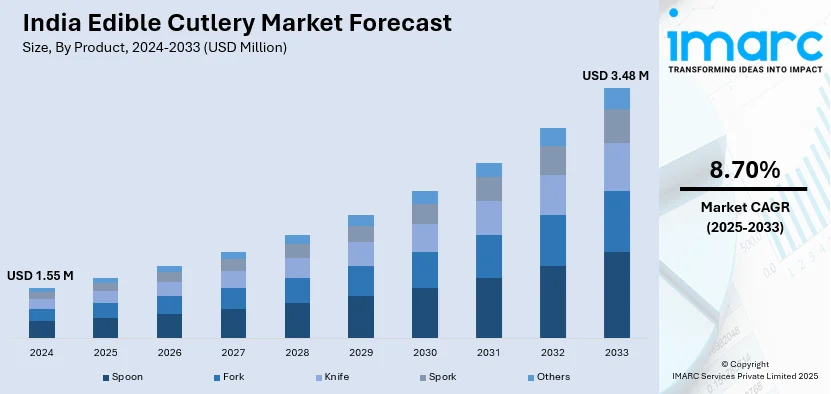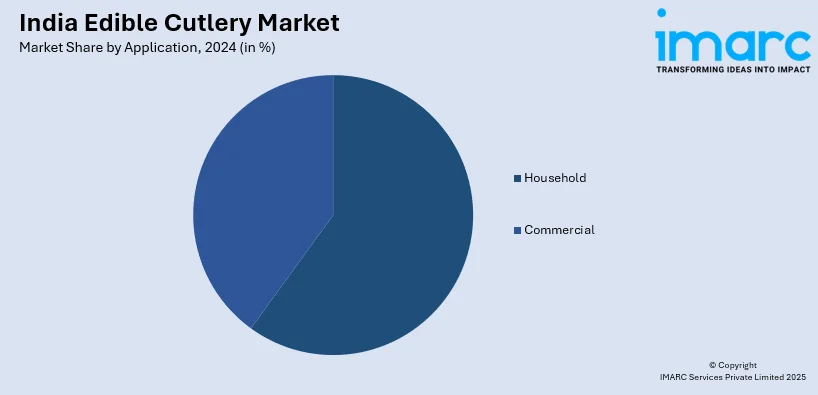
India Edible Cutlery Market Size, Share, Trends and Forecast by Product, Raw Material, Flavor, Application, Distribution Channel, and Region, 2025-2033
India Edible Cutlery Market Overview:
The India edible cutlery market size reached USD 1.55 Million in 2024. Looking forward, IMARC Group expects the market to reach USD 3.48 Million by 2033, exhibiting a growth rate (CAGR) of 8.70% during 2025-2033. Rising environmental concerns, government regulations on single-use plastics, growing consumer awareness about sustainability, increasing demand for biodegradable alternatives, innovations in food-grade materials, expansion of the hospitality sector, and corporate initiatives for eco-friendly packaging are expanding the India edible cutlery market share.
|
Report Attribute
|
Key Statistics
|
|---|---|
|
Base Year
|
2024 |
|
Forecast Years
|
2025-2033
|
|
Historical Years
|
2019-2024
|
| Market Size in 2024 | USD 1.55 Million |
| Market Forecast in 2033 | USD 3.48 Million |
| Market Growth Rate 2025-2033 | 8.70% |
India Edible Cutlery Market Trends:
Rising Adoption of Sustainable and Eco-Friendly Dining Solutions
The India edible cutlery market growth is driven by the consumers increasing demand to seek sustainable alternatives to plastic and disposable utensils. For instance, the nation's first Polylactic Acid (PLA) biopolymer manufacturing facility was established in Kumbhi, Uttar Pradesh, on February 24, 2025, by Balrampur Chini Mills Limited (BCML), a prominent integrated sugar company in India. The facility is a major step in reducing plastic waste and promoting eco-friendly materials in India by offering sustainable alternatives to banned Single-Use Plastic (SUP) items like straws, disposable cutlery, food trays, bottles, curd cups, and curry bags. Growing environmental concerns and stringent government regulations on single-use plastics are driving the demand for biodegradable cutlery made from materials like wheat, rice, and sorghum. Additionally, the rising awareness of eco-conscious dining and the zero-waste movement is encouraging food service businesses to adopt edible cutlery. Moreover, restaurants, cafes, and catering services are integrating these products to enhance sustainability credentials. The shift toward eco-friendly consumption habits, coupled with increasing urbanization and changing lifestyle preferences, is further strengthening market growth.

To get more information on this market, Request Sample
Increasing Penetration of Edible Cutlery in the Food Service Industry
The food service industry in India is increasingly embracing edible cutlery as a unique and innovative dining solution. Quick-service restaurants (QSRs), hotels, and cloud kitchens are integrating edible spoons, forks, and plates to offer an eco-friendly alternative to plastic disposables. Additionally, rising consumer demand for hygienic, non-toxic, and edible tableware is propelling market expansion. For instance, on March 14, 2024, the winners of the 'Design Challenge: Eco-Friendly Cutlery and Crockery to Substitute Single Use Plastic' were honored in an award event held in New Delhi by the Ministry of Tourism. Twenty-two hotel management institutes participated in this national competition, and the top seven—including IHM Mumbai, SIHM Raipur, and IHM Lucknow—were honored for their creative designs of edible cutlery and tableware. By opposing single-use plastic, the campaign supports sustainable tourism practices and is in line with the 'Travel for LiFE' program. Moreover, major food chains and catering businesses are adopting edible cutlery to align with sustainability goals and enhance brand image. The growing preference for convenient and biodegradable dining options, supported by increased availability through online and offline retail channels, is further positively impacting the India edible cutlery market outlook.
India Edible Cutlery Market Segmentation:
IMARC Group provides an analysis of the key trends in each segment of the market, along with forecasts at the country level for 2025-2033. Our report has categorized the market based on product, raw material, flavor, application, and distribution channel.
Product Insights:
- Spoon
- Fork
- Knife
- Spork
- Others
The report has provided a detailed breakup and analysis of the market based on the product. This includes spoon, fork, knife, spork, and others.
Raw Material Insights:
- Corn
- Wheat Bran
- Rice Bran
- Others
A detailed breakup and analysis of the market based on the raw material have also been provided in the report. This includes corn, wheat bran, rice bran, and others.
Flavor Insights:
- Plain
- Sweet
- Spicy
The report has provided a detailed breakup and analysis of the market based on the flavor. This includes plain, sweet, and spicy.
Application Insights:

- Household
- Commercial
A detailed breakup and analysis of the market based on the application have also been provided in the report. This includes household and commercial.
Distribution Channel Insights:
- Supermarkets and Hypermarkets
- Specialty Stores
- Online Stores
- Others
A detailed breakup and analysis of the market based on the distribution channel have also been provided in the report. This includes supermarkets and hypermarkets, specialty stores, online stores, and others.
Regional Insights:
- North India
- South India
- East India
- West India
The report has also provided a comprehensive analysis of all the major regional markets, which include North India, South India, East India, and West India.
Competitive Landscape:
The market research report has also provided a comprehensive analysis of the competitive landscape. Competitive analysis such as market structure, key player positioning, top winning strategies, competitive dashboard, and company evaluation quadrant has been covered in the report. Also, detailed profiles of all major companies have been provided.
India Edible Cutlery Market Report Coverage:
| Report Features | Details |
|---|---|
| Base Year of the Analysis | 2024 |
| Historical Period | 2019-2024 |
| Forecast Period | 2025-2033 |
| Units | Million USD |
| Scope of the Report |
Exploration of Historical Trends and Market Outlook, Industry Catalysts and Challenges, Segment-Wise Historical and Future Market Assessment:
|
| Products Covered | Spoon, Fork, Knife, Spork, Others |
| Raw Materials Covered | Corn, Wheat Bran, Rice Bran, Others |
| Flavors Covered | Plain, Sweet, Spicy |
| Applications Covered | Household, Commercial |
| Distribution Channels Covered | Supermarkets and Hypermarkets, Specialty Stores, Online Stores, Others |
| Regions Covered | North India, South India, East India, West India |
| Customization Scope | 10% Free Customization |
| Post-Sale Analyst Support | 10-12 Weeks |
| Delivery Format | PDF and Excel through Email (We can also provide the editable version of the report in PPT/Word format on special request) |
Key Benefits for Stakeholders:
- IMARC’s industry report offers a comprehensive quantitative analysis of various market segments, historical and current market trends, market forecasts, and dynamics of the India edible cutlery market from 2019-2033.
- The research report provides the latest information on the market drivers, challenges, and opportunities in the India edible cutlery market.
- Porter's five forces analysis assist stakeholders in assessing the impact of new entrants, competitive rivalry, supplier power, buyer power, and the threat of substitution. It helps stakeholders to analyze the level of competition within the India edible cutlery industry and its attractiveness.
- Competitive landscape allows stakeholders to understand their competitive environment and provides an insight into the current positions of key players in the market.
Key Questions Answered in This Report
The edible cutlery market in India was valued at USD 1.55 Million in 2024.
The India edible cutlery market is projected to exhibit a CAGR of 8.70% during 2025-2033, reaching a value of USD 3.48 Million by 2033.
The India edible cutlery market is driven by growing environmental concerns, government bans on single-use plastics, and increasing demand for sustainable alternatives. The rising consumer awareness, innovation in edible materials like wheat, millet, and rice flour, and expanding use in the foodservice industry further boost market growth.
Need more help?
- Speak to our experienced analysts for insights on the current market scenarios.
- Include additional segments and countries to customize the report as per your requirement.
- Gain an unparalleled competitive advantage in your domain by understanding how to utilize the report and positively impacting your operations and revenue.
- For further assistance, please connect with our analysts.
 Request Customization
Request Customization
 Speak to an Analyst
Speak to an Analyst
 Request Brochure
Request Brochure
 Inquire Before Buying
Inquire Before Buying




.webp)




.webp)












